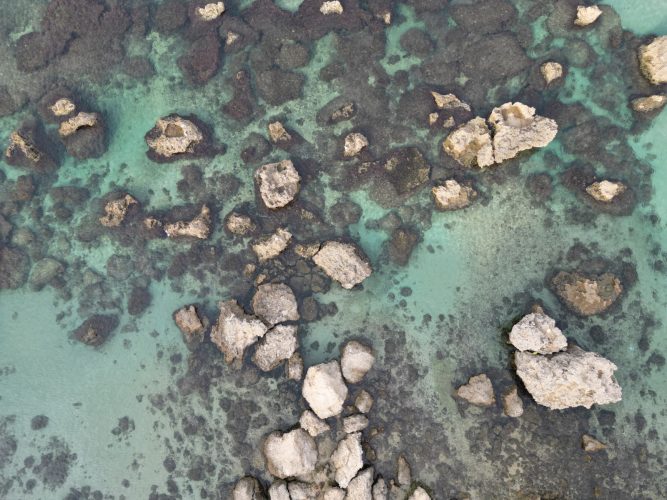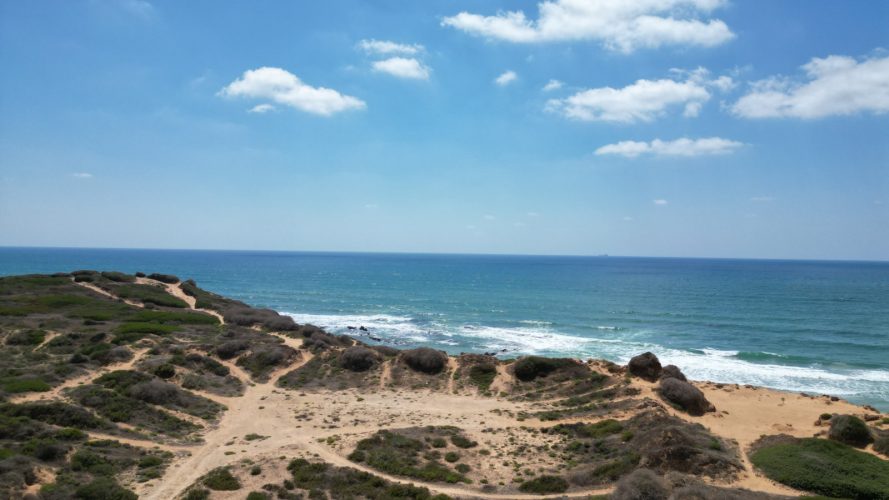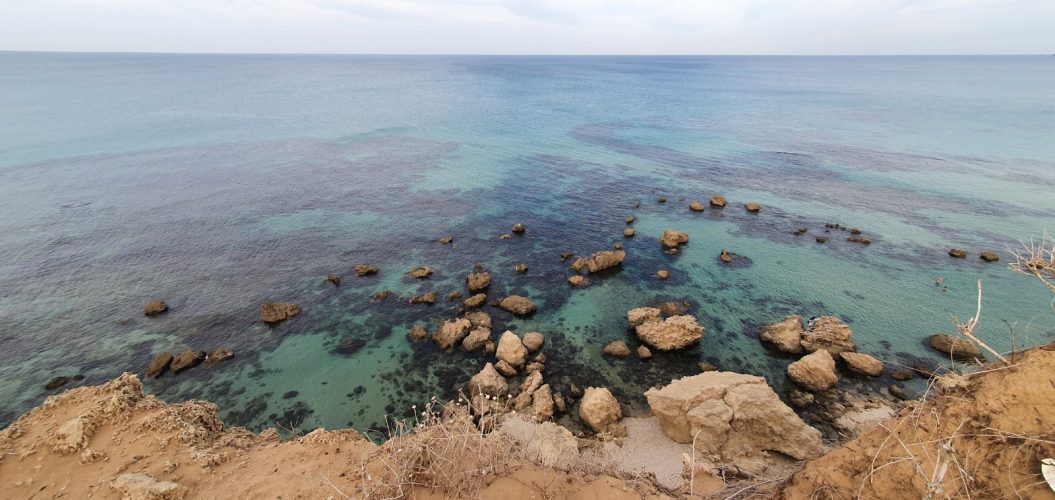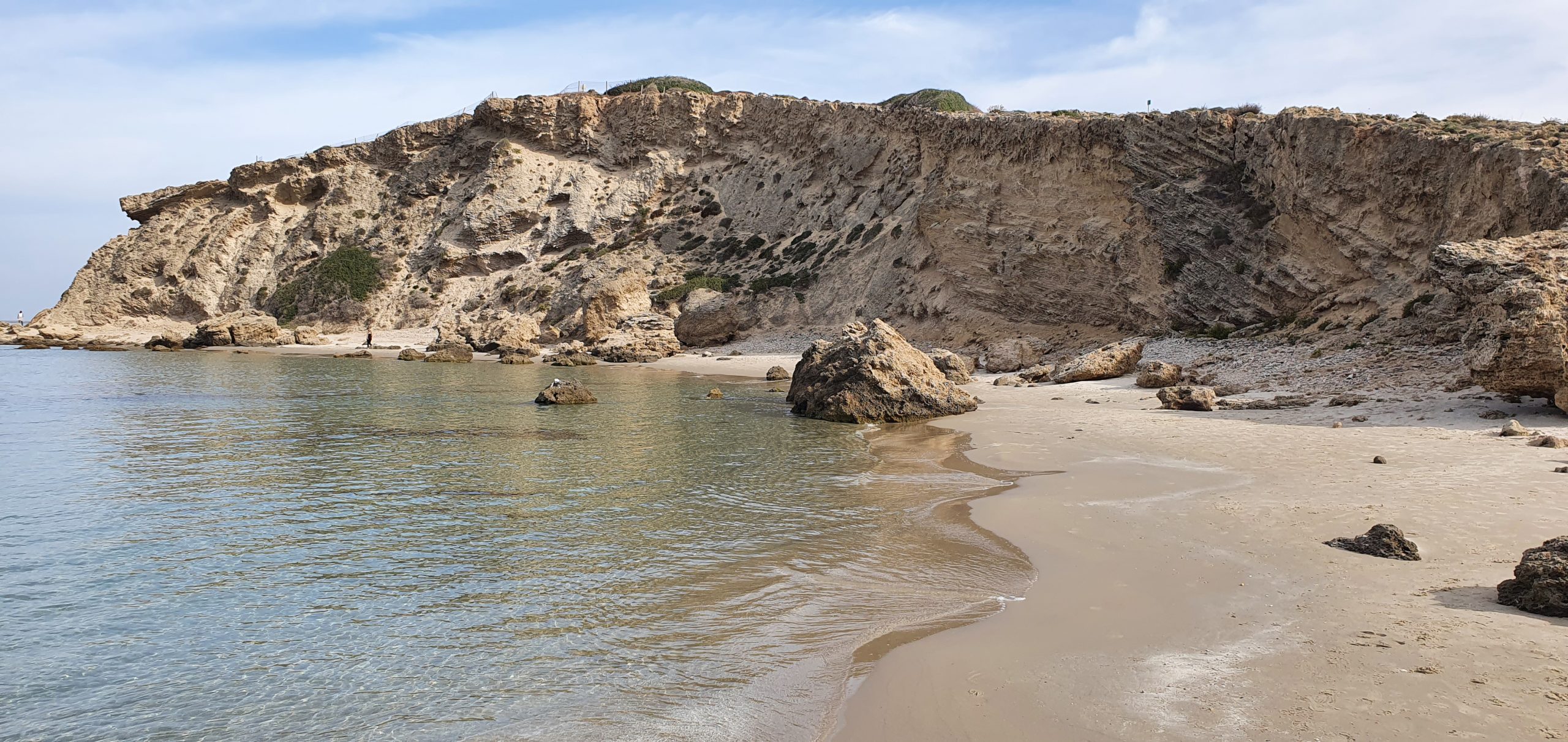Gador Beach Nature Reserve holds within it overwhelming beauty. A natural untouched feeling of raw nature that expands the heart and opens the soul in a dance of magnificent colors, shapes and a magnificent sense of calm.
When you reach this special seashore, you are able to see this vast blue space – the Mediterranean Sea. The many shades of blue of the sea, which combine with the blue of the sky, created a colorful spectacle that sanctifies blue, green and the various shades in between. The sand is soft in part, white in others and composed of endless seashells in some areas.
When you get a little closer to the water and look carefully at the blue shades of the sea, it seems like the color of the water is not the same – there are parts near the shore that look almost transparent, and the further away we were able to look, the color of the water seems to become darker.
When looking at the water from above, from the cliffs found in the Gador Beach nature reserve, you may notice that in the depth of the water, there are parts that are painted in lighter hues – shades of light blue and turquoise. According to many, this attribute of the water makes the Gador Beach nature reserve one of the most beautiful beaches in Israel, due to this phenomenon.

Get to know Gador Beach Nature Reserve!
The Gador Beach National Park and Nature Reserve are spread over a narrow coastal strip, between the neighborhood of Givat Olga (Hedera city) in the north and Michmoret in the south. In the east, the reserve borders the Sharon Coast National Park. The length of the beach in the reserve is about 2 km.
Gador Beach is the western front of Sharon Coast National Park – the only preserved coastal park forest in Israel. To the west of the beach lies the Oceanic Gador Reserve. The reserve and the national park cover 276 square meters.
In the Gador Beach Nature Reserve, you can find archaeological antiquities in the Gador mound (Tel Gador), which rises at the top of a cliff 33 m above the seashore. In the Gador mound, fragments of pottery were found – indicating that a settlement from the Iron Age II (1000-586 BC) until the Middle Ages took place there.
It was estimated that the structure found at the top of the mound used to serve as a watchtower to protect the Umeyyed from the Byzantine counter-attacks. In the mound, a structure built of hewn kurkar stones made up of three stone courses was found. Despite this finding, near the structure fragments of pottery from the end of the Byzantine period and the beginning of the Islamic period (7th-8th centuries AD) were found too.

“Blues run the game” – The colors of the blues
When arriving at Gador beach, it is impossible not to wonder, how is it possible that the water changes its color like that? Why are some parts of the sea-colored deep blue, while other parts are colored bright light blue? Several reasons cause water to take on different shades of blue.
The first reason is that the depth of the sea affects its color. Pure water is completely clear (that is, water without salts and microorganisms and many other components). But if there is a large amount of water, and the water is very deep so that there is no reflection of the seabed, the water looks very dark blue. Most of the ocean is completely dark, as almost no light penetrates deeper than 200 meters (656 feet), and no light at all penetrates deeper than 1000 meters (3,280 feet).
Another reason for the watercolor change is the sand, which changes the color of the sea two. The light scattering is increased when there are particles in the water, as they serve as additional objects that break the sun’s rays and reflect them to the water’s surface. In the coastal areas in comparison to the inner ocean parts, drifts from rivers and streams, and upwelling of sand from the bottom (caused by tides, waves, and storms) and other materials that drift into the sea can change the color of the nearby coastal waters.
In addition to these reasons, the actual main reason why the ocean looks blue is that the water absorbs colors in the red part of the light spectrum. Like a prism, colors are obtained in the blue part of the light spectrum which we see reflected from the surface of the sea.
Certain types of particles (in particular the cells of the phytoplankton, also known as algae in the vernacular) can also contain substances that absorb certain wavelengths of light, which changes their properties. As the phytoplankton contains chlorophyll, it mainly reflects the color green.

What to do at the Gador beach?
In the Gador Beach nature reserve, you can also find a lagoon called the “Chinese lagoon” – a beautiful, astonishing piece of the shore, covered with yellow sand. Along the coast, you can also find more areas of small lagoons, where you can find your private spot. In most parts along the coast, there are rocks in the water, which create a natural wave barrier – even on days when the wind is strong and the waves are high, you will be able to enjoy calm water. The bay earned its name after a group of Jews who fled Europe through Shanghai, China. Upon arriving in Israel they were placed in the Givat Olga, the neighborhood just North of Gador in Hadera. The new immigrants (Olim) came to enjoy the beach in this exact bay and the locals in the neighborhood gave the beach its nickname the “Chinese Bay”.

In the reserve, you are able to explore two biospheres at once – you can first enjoy the upper area on the cliffs, and maybe have a picnic up there, looking over to the magnificent view. Later on, you can get down to the shore and enjoy the water and the sand.
It is highly recommended to arrive in the morning (before 10 a.m.) during hot days, as the cliffs create a natural shadow from the blazing sun, and so you will be able to spend a longer time on the beach.
Amazing! How do I travel to Gador beach?
Gador beach nature reserve is very accessible as it is located in the Sharon district – in the very center of Israel. Also, Gador beach is free of any entrance fees and parking fees.
You can get to the nature reserve easily by using Waze and navigating towards “Gador Nature Reserve”. By this route, you have to take into consideration peak season and visiting hours as it might be harder to find parking spots closer to the beach. Additionally, access through the reserve is on a dirt road so treacherousness is weather dependent; although you can usually manage without a 4×4.
If you want to enjoy the best of all worlds, you can park at Olga beach in Hadera opposite the luxury beachfront VIDA TOWERS where the beaches have lifeguards and restrooms and you can walk South towards Gador along the shoreline.
Another way of arriving by car is through Michmoret beach where you can enjoy the various facilities and walk up North either along the cliffs or the shoreline leading up towards Gador.
To find out more about the VIDA luxury beachfront apartment Towers condominium complex which is just a shoreline stroll away from this magnificent nature reserve, please contact us here.


